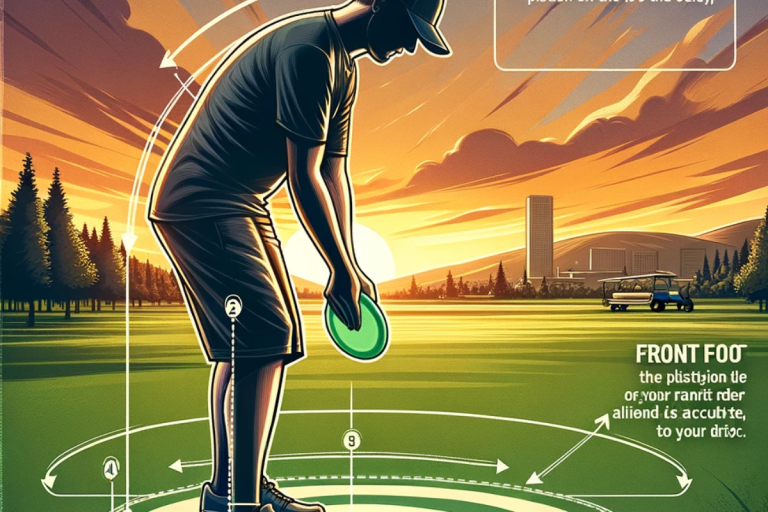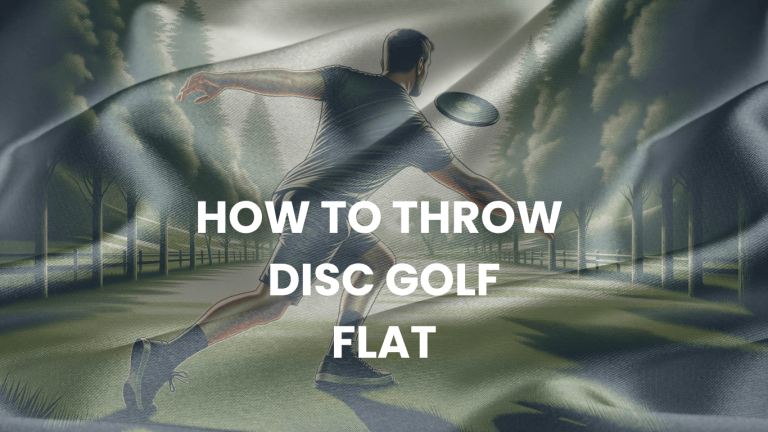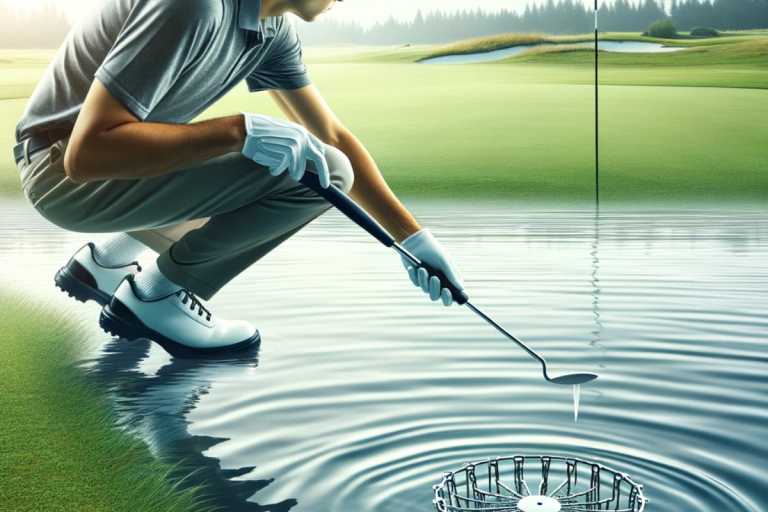How To Throw Backhand Disc Golf? The Ultimate Guide to Disc Golf’s Essential Throw
How to throw a backhand disc golf is a skill I once grappled with during my early disc golfing days. I vividly remember the feeling of watching my disc veer off-course, wondering where I’d gone wrong. The backhand throw, often considered disc golf’s cornerstone technique, can elevate your game from amateur to pro.
Yet, it requires finesse, understanding, and plenty of practice. Through this guide, I’ll share the very techniques that transformed my game, the mistakes I made, and the journey to mastering this essential throw. Together, let’s dive into the world of disc golf backhand mastery.
How To Throw Backhand Disc Golf?
How to throw a backhand disc golf was a question that haunted my early days on the course. The moment of releasing the disc, only to see it zigzag unpredictably, was both frustrating and humbling. This essential throw, a blend of art and technique in the disc golf universe, can be the difference between a good player and a great one.
But mastering it? That’s a journey. In this guide, I’ll walk you through my personal trials, the lessons I’ve learned, and the nuances that turned my throws from erratic to expert.
Join me as we explore the art of the perfect backhand.
Introduction
The art of mastering “how to play backhand disc golf” isn’t just about throwing a disc. It’s about strategy, precision, and embracing the journey that comes with every throw. For me, that journey began one sunny afternoon at my local disc golf course.
The Gravity of the Backhand
Diving into the world of disc golf, I quickly realized that the backhand throw held significant importance. Almost every seasoned player I met emphasized its role in shaping a successful game. This throw isn’t just another technique; it’s the backbone of disc golf.
Whether navigating tricky terrains or aiming for that distant basket, mastering the backhand became my mission.
My Personal Connection to the Throw
I remember my first backhand attempt like it was yesterday. Excitement mixed with nerves, I watched as my disc took an unexpected turn, veering far from the target. But every missed shot was a lesson. With each throw, I learned, adapted, and evolved.
Those early days of erratic throws, mixed with advice from fellow players and countless hours of practice, laid the foundation for my disc golf journey. Today, the backhand is an integral part of my game, a testament to perseverance and passion.
Crafting a game strategy around “how to play backhand disc golf” can make all the difference. It’s not just about the sport; it’s about the stories, experiences, and growth that come with it. Join me, and let’s make this journey together.
History of the Backhand in Disc Golf
My introduction to the world of disc golf was a transformative experience, especially when it came to understanding the rich legacy behind “how to play backhand disc golf.” Every sport has its stories, legends, and pivotal moments, and for disc golf, the backhand throw stands tall as one of its core pillars.
Origins of the Throw
The backhand’s roots trace back to the very inception of disc golf. In the early days, players like me, searching for precision and power, naturally gravitated towards the backhand technique. It wasn’t just about emulating frisbee throws we played with at picnics; it was about gaining distance, control, and consistency.
Legends of the game, whose names resonate even today, were often recognized for their signature backhand throws, setting records and influencing generations.
The Evolution and Modern Game
Fast forward to today, “how to play backhand disc golf” remains a topic of passion and debate. While the basics have remained, the techniques have evolved, thanks to the insights from professional players and advancements in disc technology.
I’ve witnessed this evolution firsthand, adapting my game over the years, and incorporating the myriad of nuanced techniques that the modern era offers. The backhand throw, once a mere adaptation of casual frisbee tosses, now holds its own as a refined skill in the professional disc golf arena.
Embracing the history of the backhand in disc golf is about more than mastering a throw. It’s a nod to the pioneers of the sport, an understanding of its roots, and an inspiration for players like me to keep pushing the boundaries.
You May Also Like: How to Drive Disc Golf?
The Science Behind the Perfect Backhand
When I first embarked on my quest to master “how to play backhand disc golf,” I soon realized it wasn’t just about arm strength or perfecting a technique. It was a dance between physics, body mechanics, and the subtle science that governs how a disc takes flight.
Physics of Disc Flight
Throwing a disc and watching it glide is magic in motion. But behind that grace is a world of physics. Factors like speed, spin, and angle, all play pivotal roles in the disc’s flight pattern. In my early days, I’d often marvel at how slight changes in release angle or wrist flick would dramatically alter my disc’s trajectory.
Understanding the science became essential for improving my backhand throw, helping me predict and control where my disc would land.
Grip, Stance, and Follow-Through
One lesson that stood out? The trifecta of grip, stance, and follow-through. A firm grip ensures power. An optimal stance provides balance and control. And a proper follow-through? It’s the difference between a disc that veers off-course and one that sails smoothly to its target.
These components act as the foundation for mastering “how to play backhand disc golf,” dictating the disc’s trajectory and overall flight performance.
Delving into Disc Dynamics
But let’s not forget aerodynamics, or as we disc golf enthusiasts often refer to it: “Disc Dynamics.” The way a disc cuts through the air, its interaction with wind currents, and its inherent design all contribute to its flight behavior.
Aerodynamics plays a crucial role, influencing factors like lift, drag, and stability. Throughout my journey, learning the intricacies of “Disc Dynamics” allowed me to select the right discs for different conditions and shots, elevating my backhand game.
Harnessing the science behind the backhand is more than just geeking out on physics. It’s about understanding the very fabric of the sport, using knowledge to enhance skill, and appreciating the profound relationship between player, disc, and the air that carries it.

Equipment Essentials
One of the biggest revelations in my journey to master “how to play backhand disc golf” was understanding that not all discs are created equal.The equipment you choose can be the difference between a throw that feels like a dream and one that’s a downright dud.
Let’s delve into the specifics of the gear that can amplify your backhand game.
Selecting the Ideal Discs for Backhand Throws
Throughout my disc golf journey, I’ve had the pleasure of experimenting with a diverse array of discs. Some gracefully soared through the air like majestic eagles, while others, well, they resembled the waddling penguins of the disc golf world. When it comes to backhand throws, I’ve discovered that discs with a stable to understable flight rating tend to yield the most favorable outcomes.
These discs are ingeniously designed to produce a natural S-curve during flight, achieving an optimal blend of distance and accuracy. For beginners, discs like the Innova Leopard and the Discraft Buzzz have proven to be reliable choices, often finding their place as essential staples in many disc golf bags.
Amateurs vs. Seasoned Competitors
In the early days of my disc golf journey, the concept of disc weight seemed somewhat elusive. However, as I gained experience, its significance became crystal clear. Beginners often find lighter discs, typically in the range of 150-165 grams, easier to control and throw effectively. As skills progress and arm speed increases, the transition to heavier discs can enhance consistency, particularly in windy conditions. Additionally, the design of the disc plays a pivotal role in achieving the desired flight path.
While I initially favored more understable discs to achieve the coveted S-curve, my journey as a seasoned player led me to incorporate overstable discs like the Innova Firebird. These discs have proven invaluable in handling specific shots and challenging wind conditions. It’s important to understand that your proficiency in “how to play backhand disc golf” is significantly influenced by the equipment you choose. It’s not just about the throw; it’s about selecting the disc that complements your skill set.

Step-by-Step Guide to the Perfect Backhand
The art of “how to play backhand disc golf” isn’t just about throwing a disc. It’s about perfecting a series of small movements that come together in one fluid motion. From my own experiences, I can assure you that each step plays a vital role in achieving that enviable throw. So, let’s break it down.
Stance and Positioning
Believe it or not, your feet play a starring role. Their positioning dictates the force behind your throw. My early days were riddled with awkward stances until I learned the sweet spot: feet shoulder-width apart with the lead foot slightly ahead. The non-throwing arm? It’s not just along for the ride. It acts as a counterbalance, ensuring that I maintain my center of gravity throughout the throw.
Grip Technique
I’ve played around with various grips, but two stand out: the power grip and the fan grip. The power grip, with all fingers tucked tightly beneath the disc, offers maximum power. The fan grip, fingers spread out, gives me more control, ideal for shorter throws. But the real game-changer? Achieving “Grip Consistency.” By maintaining a consistent grip, I’ve found my throws are more predictable and my results, more repeatable.
Throwing Motion
The hips don’t lie, especially in disc golf. A solid hip rotation adds momentum, turning my body into a powerhouse. Then comes the whip effect, a smooth transition of energy from the arm down to the wrist. This motion culminates at the “Release Point” – a term I’ve come to respect deeply. It’s all about timing and precision, letting the disc go at the optimal moment to achieve the desired flight path.
Follow-Through
The throw isn’t over once the disc leaves my hand. A proper follow-through ensures I maintain balance and can swiftly transition to my next move. I’ve also learned the value of observing the disc’s flight. Each throw offers a lesson, and by watching closely, I can make those minute corrections that refine my technique.
Piecing together the puzzle of “how to play backhand disc golf” has been a journey of trials, errors, and eventual triumphs. By focusing on each step, and understanding its importance, I’ve transformed my backhand game. It’s not just about strength or skill; it’s about understanding the intricacies and putting them into practice.

Common Mistakes and Their Fixes
When I first dipped my toes into the world of “how to play backhand disc golf”, I made more mistakes than I care to admit. But with every stumble, I learned. If you’re on a similar journey, understanding common pitfalls can be your first step toward mastery. Here’s my lowdown on some usual suspects and how to dodge them.
Overpowering the Throw
I get it. The thrill of throwing the disc with all your might is tempting. But more power doesn’t always equal more distance. In fact, my early days were marked by discs veering way off course because I threw them too hard. The fix? Focus on technique, not power. Smoothness and consistency in my release have given me far better results than brute strength ever did.
Incorrect Grip
You’d be surprised at the difference the right grip makes. In my rookie days, I’d grip the disc too tight or too loose, leading to erratic throws. The key is to find that sweet spot. The “Grip Consistency” I mentioned earlier comes into play here. Find what feels comfortable, ensure your fingers are positioned correctly beneath the disc, and maintain that grip every time.
You May Also Like: How to Throw Disc Golf?
Neglecting the Non-Throwing Arm
It’s easy to overlook, but the arm you’re not using to throw? It’s crucial. When I first started, I’d often leave my non-throwing arm dangling uselessly by my side. The result? A lopsided throw. By using my non-throwing arm as a counterbalance and engaging it actively in the throwing process, I’ve achieved a more stable, accurate release.
No one is immune to mistakes, be it beginners or seasoned pros. But in the world of “how to play backhand disc golf“, it’s not about avoiding errors; it’s about learning from them. With the right insights and a touch of perseverance, anyone can transform their backhand game.
Training Tips and Drills
Back when I first embarked on my “how to play backhand disc golf” journey, it became crystal clear that mastery wasn’t about natural talent. No, it was all about practice. And not just any practice, but smart, targeted drills. Allow me to share some golden nuggets I’ve picked up along the way.
Field Work for Precision
One of the game-changers for my backhand was simply finding an open field. Here, I’d select a target – a tree or a specific patch of grass – and throw towards it. The freedom to make errors, observe, and adjust without the pressure of a game was invaluable. This drill sharpened my accuracy and taught me how different discs reacted.
Mirror Drills for Form
There’s a saying: “It’s hard to fix what you can’t see.” That’s why practicing my throwing form in front of a mirror became a cornerstone of my training. Observing my stance, the movement of my non-throwing arm, and my release point in real-time was enlightening. Over time, this self-awareness allowed me to iron out kinks and develop a consistent, efficient throwing technique.
The Power of Consistency
My mantra? “Consistency is key.” It’s tempting to go hard with hours of practice when the motivation is high. But what really made the difference for me was setting a regular schedule. Short, focused sessions, several times a week, proved more beneficial than marathon ones. They kept my skills sharp and ensured I never felt overwhelmed or burnt out.
Training to perfect the backhand throw in disc golf is a rewarding journey. With the right drills, self-awareness, and commitment to regular practice, anyone can elevate their game. I’m living proof of that.
Conclusion
Ah, the exhilarating journey of mastering the backhand throw in disc golf! It’s incredible to think about how far we’ve come, from grasping the basics to refining intricate techniques. Let’s take a moment to reflect and gather our thoughts.
Key Takeaways
Throughout our exploration into “how to play backhand disc golf,” some techniques truly stood out. The power of stance and positioning cannot be overstated. Finding that sweet spot with the right grip, be it the power grip or fan grip, is vital. And who could forget the magic of hip rotation, the whip effect, and the importance of the release point? These elements combine to make the backhand not just a throw, but an art form.
Your Turn to Shine
Now, it’s over to you. Harness that enthusiasm, grab your favorite disc, and head to the nearest course or open field. Remember, every champion started as a beginner. Every failed throw, every missed target, it’s all part of the learning curve. So, keep practicing, refining, and most importantly, enjoying the journey. You’ve got this!
FAQs
Q1:What is the backhand technique in disc golf?
Answer:
The backhand technique involves gripping the disc with the back of your hand facing forward and releasing it with a smooth motion, similar to a tennis backhand.
Q2:Is the backhand throw essential for disc golf beginners?
Answer:
Absolutely, mastering the backhand throw provides a foundation for various shots and is crucial for new players.
Q3:How does grip style affect a backhand throw in disc golf?
Answer:
Grip style, like the power grip or fan grip, influences disc control and distance, making it essential for the desired throw outcome.







